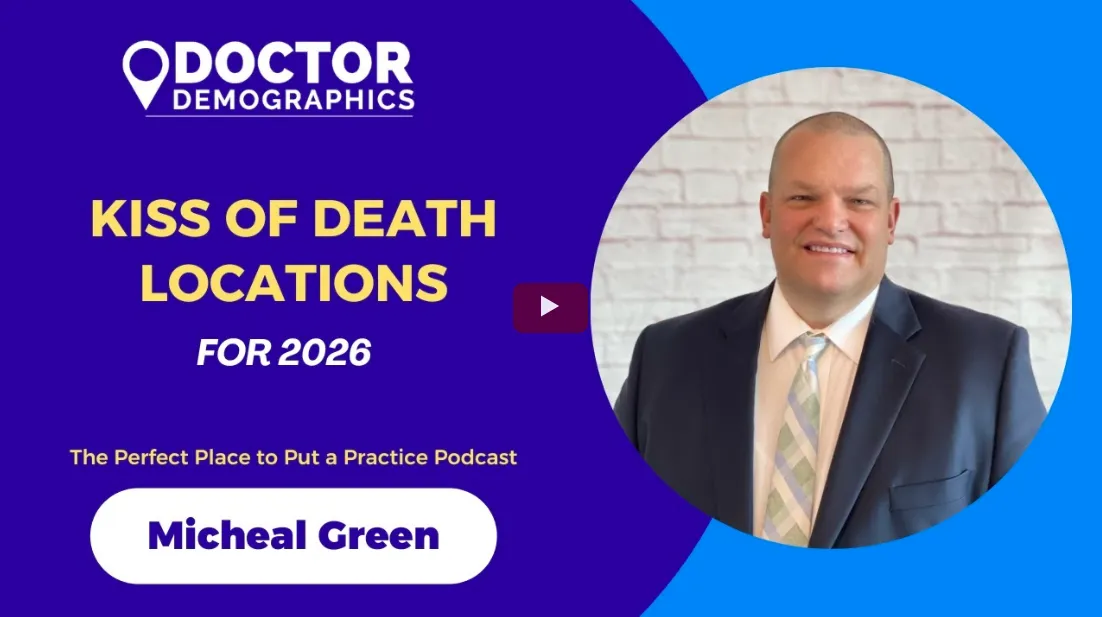Articles and Podcasts

Kiss of Death Locations for 2026
Kiss of Death Locations for 2026
Podcast Transcript:
Kiss of Death Locations for 2026
Welcome to The Perfect Place to Put a Practice, the podcast dedicated to helping private practice owners like you find the ideal spot to launch and grow their businesses. I’m your host, Mike Green, from Doctor Demographics.
Alright, let's dive into today’s topic: "Kiss of Death Locations for 2026." If you’re thinking about opening a new practice next year, location is everything. We’ve talked before about hot spots that can supercharge your success, but today, we’re flipping the script. I’m going to highlight eight markets—ranging from small towns to major cities—that could be the kiss of death for new practice owners. These are places plagued by population loss, non-business-friendly governments, economic stagnation, high competition, or other factors that make it nearly impossible to build momentum. We’ll count them down from number eight to number one, with data-backed reasons why they’re toxic. My goal? To help you avoid sinking time and money into a doomed venture.
Now before we get started, every year when we do this episode of the podcast I always need to make this disclaimer. Just because this town/area is on the list does not mean you can’t be successful. As a matter of fact, over the years we have placed doctors in amazing demographic areas and they have failed because they did not take care of the external things that will equal success such as reputation, community involvement, etc. On the other side of the coin, we’ve had doctors go into absolutely terrible areas, of which we have told them they are terrible demographically, and they have done amazing things. Why? Because they’re amazing people who are committed to marketing and reputation management. So, in short, demographics is not the only factor you should be considering when finding a place to practice. They are other indicators for success that will likely play a major role into whether you ultimately find success or not. Okay, is that clear enough?
First, why do some locations earn the "kiss of death" label? It boils down to sustainability. A great practice needs a growing patient base, affordable operations, and supportive policies. When a market has shrinking populations—like we’ve seen in Rust Belt cities—demand for services dries up. Add in anti-business governments with high taxes, strict regulations, or poor infrastructure, and you’re fighting an uphill battle. According to the U.S. Census Bureau’s 2024 data, over 50% of U.S. counties experienced population decline last year, and that trend is accelerating into 2026. Pair that with reports from the Tax Foundation showing states like Illinois and New York with some of the worst business climates, and you’ve got red flags everywhere. For private practices, where patient retention and cash flow are king, these factors can lead to closure rates as high as 40% in the first two years, per Small Business Administration stats. So, let’s break down the worst offenders.
Starting at number eight: Youngstown, Ohio—a small market in the heart of the Rust Belt. Youngstown has lost over 10% of its population since 2010, dropping to around 60,000 residents by 2025 projections. This decline is driven by manufacturing job losses and youth outmigration, leaving an aging, low-income demographic that struggles with healthcare affordability. The local government isn’t helping; high property taxes and slow permitting processes make setup costs prohibitive. For a new dentist or vet, you’d face low demand for elective services and competition from established practices clinging to survival. Data from the Ohio Department of Health shows a surplus of providers relative to the shrinking population, meaning thin margins and high failure risk.
Number seven: Flint, Michigan—another small to midsize market reeling from economic woes. Flint’s population has plummeted 20% in the last decade to under 80,000, thanks to the water crisis aftermath and industrial decline. Unemployment hovers at 8%, double the national average, per 2025 Bureau of Labor Statistics forecasts. The state government offers some incentives, but local regulations are burdensome, with zoning laws that delay openings by months. For optometrists or veterinarians, the low median income—around $30,000—means patients often skip preventive care. A 2024 study by the Michigan Health Council highlights oversaturation in basic services, making it hard for newcomers to gain traction without deep discounts that erode profits.
At number six: Buffalo, New York—a midsize city with harsh winters and harsher economics. Buffalo’s population dipped another 1.5% in 2024, continuing a 20-year trend down to about 275,000. High state taxes—New York ranks near the bottom in the Tax Foundation’s 2025 Business Climate Index—combined with local fees, squeeze small businesses. Non-business-friendly policies, like strict labor laws and high energy costs, add to the pain. For practices, the aging population (18% over 65) demands more specialized care, but outmigration of young families reduces overall volume. The New York State Dental Association reports stagnant growth in patient bases here, with many practices closing due to unsustainable overhead.
Number five: St. Louis, Missouri—a midsize market facing urban decay. St. Louis has lost 5% of its population since 2020, now at around 290,000, due to crime rates and job flight. The local government’s fragmented structure—multiple overlapping jurisdictions—creates regulatory nightmares, from licensing delays to high sales taxes. Economic stagnation, with flat GDP growth projected for 2026 per Federal Reserve data, means patients are cutting back on non-essential visits. Veterinarians might struggle with pet owners prioritizing basics over wellness exams, while dentists face competition in a market where demand hasn’t kept pace with supply.
Coming in at number four: Baltimore, Maryland—a midsize to large urban area in decline. Baltimore’s population shrank by 2% in 2024 to about 570,000, driven by high crime and poor schools pushing families out. Maryland’s government is moderately business-friendly statewide, but Baltimore’s local policies include high property taxes and slow infrastructure improvements. For optometrists, the low insurance coverage rates—15% uninsured per KFF.org—limit reimbursements. A 2025 Urban Institute report notes healthcare deserts in parts of the city, but oversaturation downtown leads to cutthroat competition and burnout.
Number three: Portland, Oregon—a midsize city with progressive policies gone awry. Portland saw a 1% population drop in 2024, now at 630,000, amid homelessness issues and business exodus. Oregon ranks low in business friendliness due to high personal income taxes and strict environmental regulations that inflate costs. Local government’s focus on social programs over economic incentives leaves little support for small practices. For veterinarians or dentists, the high cost of living drives up staff wages, while patient outmigration reduces loyalty. The Oregon Health Authority’s 2025 data shows declining practice openings here, with many citing regulatory burdens as the culprit.
At number two: Chicago, Illinois—a large market drowning in debt. Chicago’s population fell by 0.8% in 2024 to 2.6 million, continuing a trend fueled by high crime and taxes. Illinois has one of the worst business climates, per the Tax Foundation, with sky-high property taxes and pension burdens trickling down to locals. Non-business-friendly policies, like complex licensing and union mandates, make hiring tough. For practices, the saturated market—over 5,000 dentists alone—means fierce competition, while economic forecasts from the Federal Reserve predict sluggish growth into 2026. Patient retention suffers as residents flee to suburbs, leaving urban practices high and dry.
And the number one kiss of death location for 2026: San Francisco, California—a large, iconic city turned cautionary tale. San Francisco lost 7% of its population since 2020, down to about 800,000, due to sky-high housing costs and remote work exodus. California’s regulations are notoriously anti-business, with strict labor laws, high taxes, and environmental mandates that jack up overhead. Local government’s focus on tech over small businesses offers no incentives for healthcare startups. For optometrists or vets, the median income disparity creates a bifurcated market—affluent patients seek premium care elsewhere, while others can’t afford it. A 2025 California Health Care Foundation report highlights practice closures at a 25% rate here, driven by unsustainable rents and competition from corporate chains.
Whew, that’s our list of eight kiss of death locations for 2026. Remember, these aren’t hopeless places forever, but for new practice owners, they’re high-risk bets. The common threads? Population loss erodes your patient pool, non-business-friendly governments pile on costs, and economic decline stifles demand. If you spot these red flags—check Census data, tax indexes, and local health reports—pivot to growing markets like those we’ve covered in past episodes.
Before we wrap up, a quick tip: Always do your due diligence with demographic analysis. At Doctor Demographics, we specialize in spotting winners and avoiding losers to help you build a thriving practice. Head to our website at doctordemographics.com for a free consultation.
Alright, folks, that’s it for today’s episode of The Perfect Place to Put a Practice. I hope this helps you steer clear of trouble and find your perfect spot. If you found this helpful, please subscribe, leave us a review, and share it with a colleague who’s scouting locations. If you’d like to continue the conversation, visit us at www.doctordemographics.com or give us a call at (844) 704-0499. We’ll see you on the next episode.
Our Leadership

Scott McDonald
"Demographics is more than just facts and figures. It is the foundational story in which we develop the right strategy and plan to create successful practices over the long-term. Markets change, economies fluctuate, and internal goals differ. Our goal at Doctor Demographics is to provide you with not just the data, but experienced analysis to help you create the practice you've always dreamed of having."
Scott McDonald
Founder - Doctor Demographics

Mike Green
"Mike Green is a seasoned healthcare strategist with over 30 years of experience specializing in practice placement/promotion strategies, demographics, and psychographics. He empowers doctors and healthcare entrepreneurs to build thriving, patient-centered practices through data-driven strategies. Having conducted over 10,000 market studies over the. years, Micheal transforms insights into actionable plans, helping practice owners establish and scale their practices across the United States and beyond. His proven approach ensures practices not only compete but excel in their communities. Micheal’s expertise delivers sustainable success for new and established practices alike. "
Mike Green
Owner - Doctor Demographics



Facebook
Instagram
X
LinkedIn
Youtube
TikTok